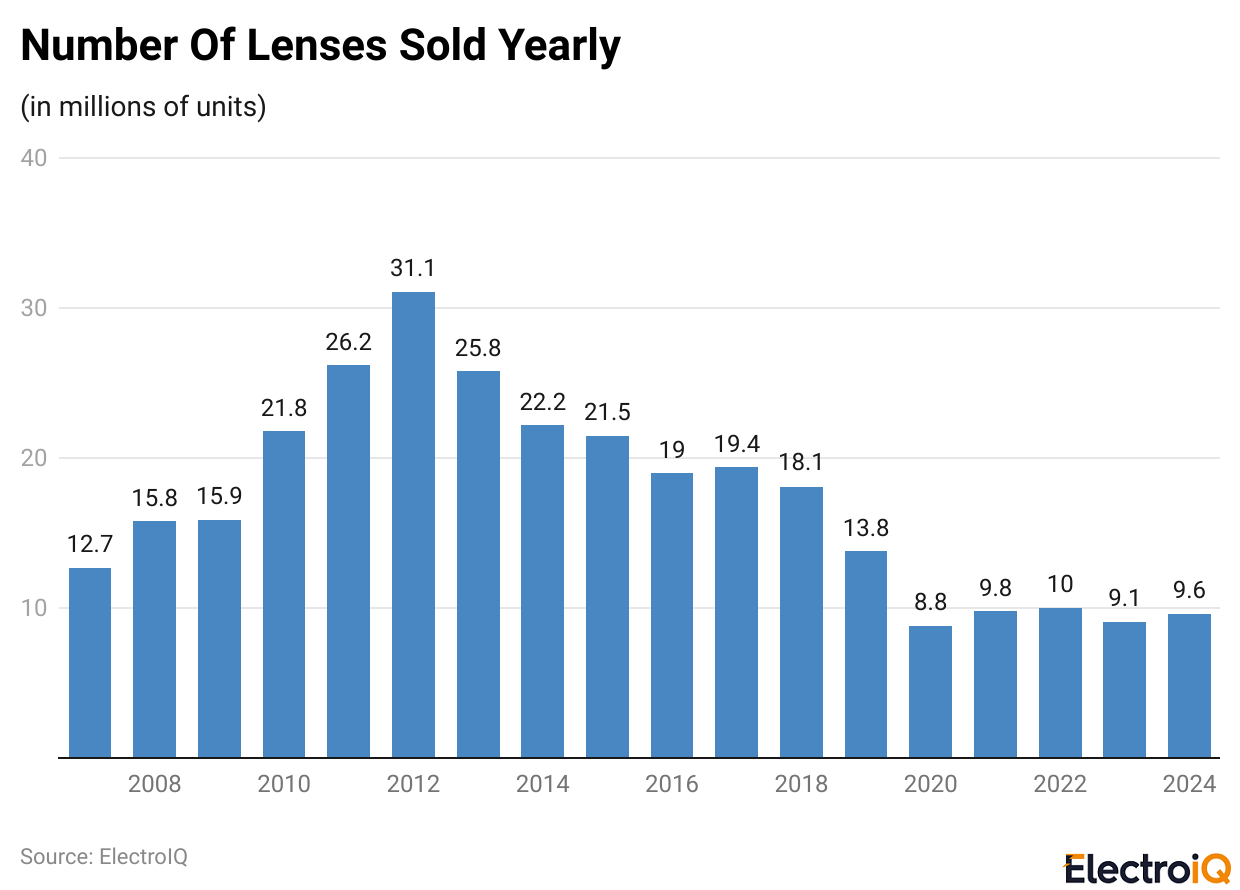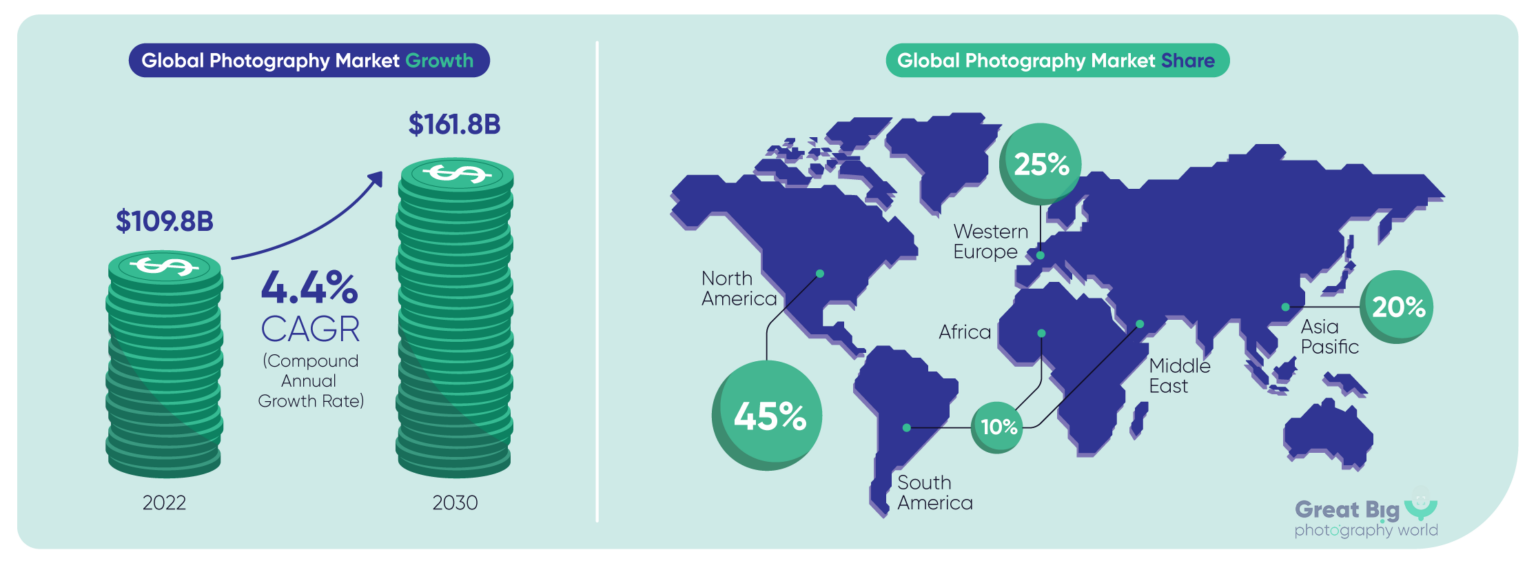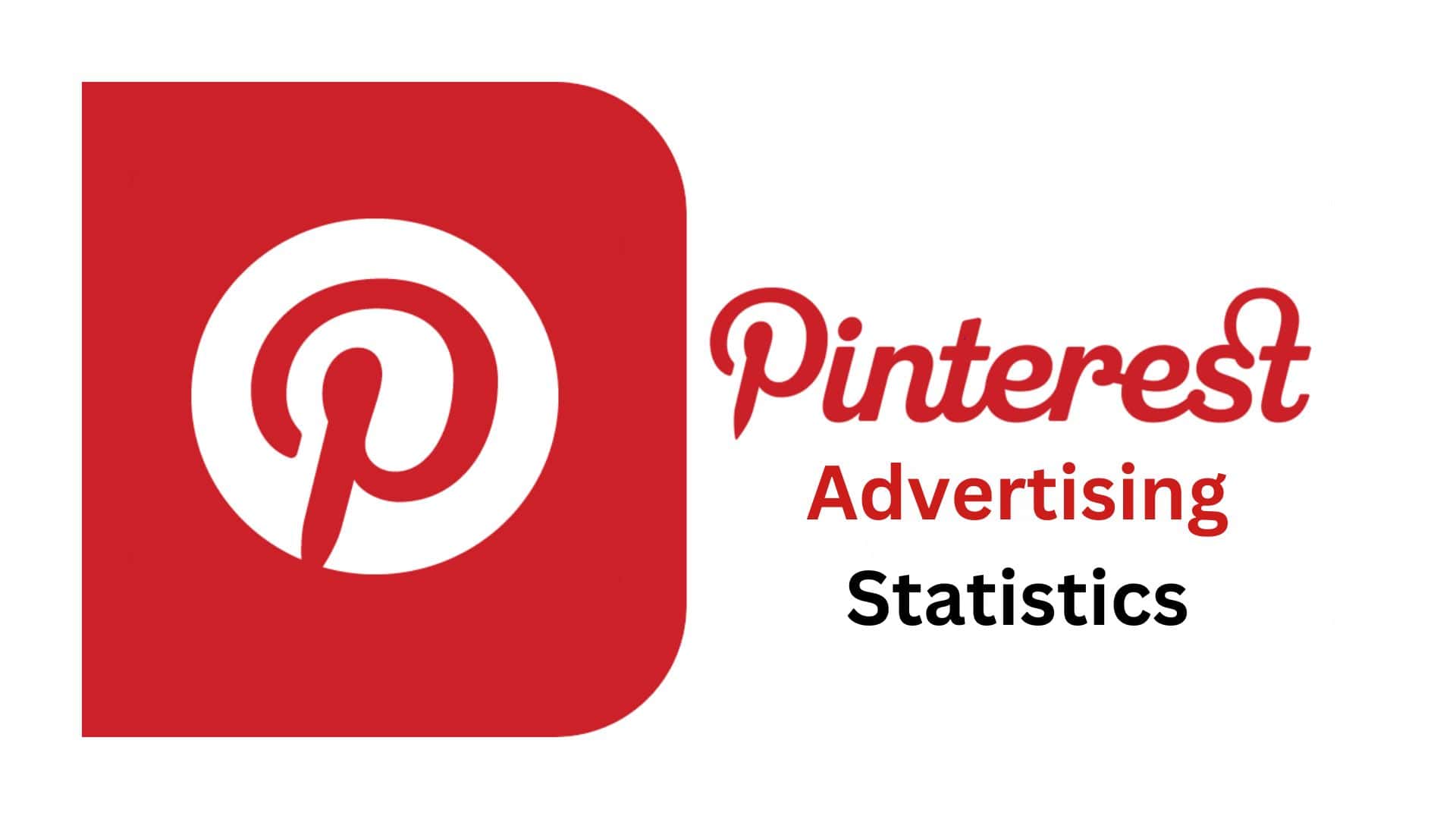Cameras Statistics By Usage, Type, Market Size and Facts (2025)
Updated · Nov 19, 2025

Table of Contents
- Introduction
- Editor’s Choice
- History of Cameras
- Fun Facts About Cameras and Photography
- Number of Cameras Sold
- Number of Camera Lenses Sold
- Worldwide Shipments of 3D/Digital Cameras
- Smart Camera Marketing Statistics
- The Camera’s Impact On Our Digital Lives
- Photography Statistics
- Surveillance Camera Statistics
- Digital Camera Statistics
- Action Camera Statistics
- 3D Camera Market Data And Trends
- Smart Home Camera Statistics
- Top Most Expensive Camera
- Conclusion
Introduction
Camera Statistics: The world of cameras in 2025 is quite different from 2020, with higher quality and greater ease of use. Still, the smartphone cameras are good enough for casual photographs, and other areas are developing rapidly, too (security cameras, 3D imaging, image sensors). Besides, the photo cell phone continues to gain strong market share, while the camera sector remains stable and even shows growth in some segments.
There is still demand for professional gear, mirrorless systems, and content-creator tools. This article will disclose recent Camera statistics and their market trends.
Editor’s Choice
- For the first time since 2017, the dedicated camera market has experienced growth, rising from 7.8 million units in 2023 to 8.3 million in 2024, a 6% increase.
- The 2024 lens sales amounted to 9.6 million units; that figure includes almost 4.5 million full-frame lenses and more than 5 million APS-C lenses, with both segments growing by approximately 5%.
- According to historical data from CIPA, the peak of camera shipments occurred during the 2000 to 2010 digital boom, when over 120 million units were sold, followed by a 94% decline between 2010 and 2023, largely due to the emergence of smartphones.
- The shipped quantity of fixed-lens cameras was only 1.7 million units in 2023, indicating a significant drop from the industry’s peak.
- The markets for smart and security cameras are flourishing, with the smart camera market being valued at USD 7.04 billion in 2023 and projected to exceed USD 12 billion by 2030.
- The worldwide security camera market was valued at USD 18.3 billion in 2024 and is projected to exceed USD 48 billion by 2034.
- Home security cameras reached nearly USD 10 billion in 2024 and might reach USD 56.47 billion by 2033.
- More than half of U.S. households already use at least one security camera, indicating a general trend toward adoption.
- Despite wired cameras commanding a 51% share in 2024, wireless models are rapidly catching up thanks to the hassle-free installation.
- In 2024, the Asia-Pacific region was at the forefront of the smart camera market, with a share of more than 43%, and is expected to hold 45% in 2025.
- The growth in IoT is a significant factor in the adoption of smart cameras, as the number of connected devices is projected to reach 18.8 billion in 2024.
- By 2034, the 3D camera market, valued at USD 7.21 billion in 2024, will continue to grow at a remarkable 17% CAGR, reaching USD 35.25 billion.
- The major drivers of 3D camera growth are AR/VR, self-driving cars, drones, and industrial automation.
- Canon and Sony are working together to dominate the 3D camera market with a share of 26.1% each, while Nikon, Fujifilm, and Panasonic follow as contenders.
- Among the significant technology investments are Apple’s purchase of LinX for USD 345 million and Intel’s acquisition of Itseez for USD 50 million to improve 3D sensing.
History of Cameras
- 1826–1827: The oldest surviving permanent camera photograph, “View from the Window at Le Gras,” was produced by Nicéphore Niépce using heliography.
- 1839: The daguerreotype process was publicly announced in Paris on August 19, marking photography’s first widely adopted method.
- 1841: William Henry Fox Talbot patented the calotype, introducing the paper-negative process that enabled multiple positive prints.
- 1851: Frederick Scott Archer described the wet collodion process, delivering sharp glass negatives and faster exposures.
- 1871: Richard Leach Maddox introduced gelatin dry plates, allowing plates to be prepared in advance and developed later.
- 1888: George Eastman commercialized the Kodak camera and popularized roll film with the slogan “You press the button, we do the rest.”
- 1900: Kodak launched the Brownie, a low-cost box camera that brought snapshot photography to the mass market.
- 1907: Autochrome Lumière became the first widely used practical color process for still photography.
- 1925: The Leica I was presented publicly, establishing the compact 35 mm format as a mainstream photographic system.
- 1935: Kodachrome color reversal film was introduced, advancing high-quality color photography for motion and still images.
- 1936: The Kine Exakta debuted as the first regular-production 35 mm single-lens reflex camera.
- 1948: Polaroid’s Land Camera Model 95 went on sale, delivering the first consumer instant prints in about one minute.
- 1959: Nikon introduced the Nikon F, defining the modular professional 35 mm SLR system era.
- 1969: The charge-coupled device was developed at Bell Labs, becoming a foundational image sensor for digital cameras.
- 1975: Steven Sasson at Kodak built the first self-contained digital camera prototype, recording 100×100-pixel images to tape.
- 1981: Sony unveiled the Mavica, a prototype electronic still video camera that captured images to magnetic disks.
- 1988: Fujifilm’s Fujix DS-1P demonstrated solid-state storage for digital still images using removable SRAM cards.
- 1991: Kodak released the DCS 100, the first commercially available DSLR, based on a Nikon F3 body.
- 1999: Nikon launched the D1, a self-contained professional DSLR that accelerated the shift from film to digital.
- 2000: Sharp’s J-SH04 arrived in Japan, popularizing the camera phone with a fully integrated mobile camera.
- 2005: Canon introduced the EOS 5D, making full-frame digital capture more accessible in a standard-size DSLR body.
- 2008: Olympus and Panasonic announced the Micro Four Thirds standard; Panasonic’s Lumix G1 became the first digital mirrorless interchangeable-lens camera.
- 2012: Nokia’s 808 PureView introduced a 41-megapixel smartphone sensor, showcasing pixel-binning and oversampling benefits.
- 2013: Sony’s α7 series brought the first full-frame sensors to mirrorless cameras, reshaping the high-end market.
- 2016: Apple’s iPhone 7 Plus adopted a rear dual-camera system, normalizing computational depth effects in mobile imaging.
Fun Facts About Cameras and Photography
- The oldest surviving photograph was created in the 1820s by Joseph Nicéphore Niépce using a camera obscura; the exposure is estimated to have taken several hours of continuous light.
- The first self-contained digital camera was built at Kodak in 1975 by engineer Steven Sasson; it weighed about 3.6 kg (8 lb), recorded images at 100 × 100 pixels (0.01 megapixel) and needed about 23 seconds to save one black-and-white photo to cassette tape.
- Global digital camera sales have fallen sharply since the smartphone era; one analysis reports an 87% drop in digital camera sales from 2010 because most casual users switched to phones.
- Today, smartphones dominate everyday photography; recent estimates suggest that about 92.5% of all pictures are taken with smartphones, leaving only 7.5% for traditional cameras.
- Despite the decline in unit volumes, the dedicated camera industry still ships millions of devices; CIPA figures show around 6.0 million interchangeable-lens and compact camera bodies shipped worldwide in 2023, along with about 9.6 million lenses.
- CIPA shipment data indicate that camera demand has shown signs of recovery; in November 2024, total camera shipments were about 27.2% higher than in November 2023, although monthly volumes remain well below early-2010s peaks.
- On popular photo-sharing platforms, smartphone brands already dominate device rankings; on Flickr, smartphones accounted for roughly 50% of all images uploaded in 2017, with a particularly strong presence of one leading smartphone brand.
- Modern life generates huge numbers of digital photos; recent estimates indicate around 1.8 trillion photos are taken per year, which equals roughly 5 billion photos every day and over 57,000 photos every second.
- A typical smartphone user stores close to 2,800 images in the device gallery, yet many are rarely viewed, which has led social researchers to discuss the risk of “forgotten” digital memories.
- Physical prints are seeing renewed interest among younger users; surveys in 2025 show that about 43% of Gen Z adults regularly print digital photos, roughly eight times the share of some older generations, and they print about twice as many photos per year as other age groups.
- The key sensor technology behind modern digital cameras, the charge-coupled device (CCD), was developed at Bell Labs in 1969; its co-inventor George E. Smith later received the 2009 Nobel Prize in Physics for this contribution, which transformed photography, astronomy, and medical imaging.
Number of Cameras Sold

(Reference: lensvid.com)
- In 2024, digital cameras are expected to generate more than USD 24 billion in revenue, although unit sales will be lower.
- The camera industry had its first year-on-year growth in 2024 after a dry spell that lasted since 2017. Global camera sales and shipments rose from 7.8 million units in 2023 to 8.3 million in 2024, a slight increase of about 6%.
- This surge in demand is significant, as the industry had been in decline for several years, mainly due to the rise of smartphones and changes in consumer habits.
- On the contrary, the question arises whether the camera market has fully recovered and will continue to grow as a result of this increase. It’s a bit early to declare that.
- A single year of growth is certainly a positive sign, but it’s not a long-term guarantee of an upward trend.
- Changes in technology, economic climate, and the extent of demand for traditional cameras as compared to smartphones could be reasons for the industry patterns to shift.
- Looking at the subsequent parts of the article—such as the types of cameras that grew, those that declined, and the performance of different brands—will offer more context.
- These particulars will indicate whether 2024 was merely a brief upswing or the genesis of a real recovery trend in camera sales.
Number of Camera Lenses Sold

(Reference: lensvid.com)
- Analysing lens sales is a very effective way to understand the current state of the camera industry, since lenses are long-term investments and are usually purchased only after people are very committed to the system.
- In 2024, lens sales rose by approximately 0.5 million compared to 2023, which is a strong sign of customer engagement in the camera market.
- Nonetheless, the raw figure would not be enough to get the whole story. It is necessary to determine how many of the total lenses were designated for full-frame (FF and larger) cameras and how many for APS-C (and smaller) systems.
- Of the complete 9.6 million lenses sold in 2024, about 4.5 million were of full-frame or larger size, while a bit more than 5 nm were of APS-C or smaller.
- Both classifications have increased by almost 5% from the previous year, indicating a uniform rise in demand among different sensor formats.
- It also means that both professional or advanced users (who often buy full-frame gear) and non-expert or casual shooters (who typically use APS-C systems) are responsible for the growth.
Worldwide Shipments of 3D/Digital Cameras

(Source: petapixel.com)
- The chart representing 3D camera statistics portrays the entire global shipment records of photo cameras by CIPA. Hence, it is a proper assertion that the manufacturing plants count all cameras shipped by CIPA members since 1951: OM Digital Solutions, Canon, Fujifilm, Sony, Nikon, Panasonic, and others.
- The graph depicts the slow but steady increase in camera sales from the 1950s to the 1970s, with film camera sales shown in orange. A massive wave of sales followed the sales boom in the 1980s during the digital camera era from 2000 to 2010.
- Sales reached their all-time high, surpassing 120 million units in a year, but then the whole market began to decline from 2010 to 2023 as smartphones replaced traditional point-and-shoot cameras.
- According to Statista, camera shipments declined by 94% from 2010 to 2023, effectively erasing years of growth.
- CIPA members shipped just 1.7 million fixed-lens cameras in 2023, a drastic decline from what had been the core of the digital camera market.
- Thanks to AI features on smartphones, most consumers will no longer need to buy separate cameras, as smartphone image quality is good enough and even meets the demands of the average working consumer.
- Moreover, as AI and smartphone camera features improve, the likelihood that phone cameras will become more sophisticated suggests that dedicated cameras will, in the near future, be of little concern to a large segment of real daily users.
Smart Camera Marketing Statistics
- The smart camera industry has been growing rapidly, driven by increasing demand for monitoring, home security, and connected technologies.
- The market value in 2023 was USD 7.04 billion, and it is safe to say that smart cameras are now part of everyday life for both consumers and businesses.
- This sector has a projected CAGR of around 9% through 2030, making it a major area of growth as innovation keeps pace.
- It is estimated that by 2025, the market will be worth USD 6.84 billion and will increase further to USD 12.07 billion by 2030, underpinned by the growing trust in AI and connected devices for security and convenience.
- The IP camera segment alone was valued at USD 5.53 billion in 2023 and is expected to grow dramatically, potentially reaching USD 16 billion by 2032. This reflects a major shift away from traditional analogue systems as IoT and smart city initiatives become more common.
- In 2024, the global security camera market stood at USD 18.3 billion, with forecasts suggesting it may grow to USD 48.1 billion by 2034.
- The rise in global safety issues and the acceptance of surveillance technology among consumers are the major factors that have driven the trend.
- The security cameras market for smart homes also indicated noticeable growth and was valued at almost USD 10 billion in 2024.
- It is expected to reach USD 56.47 billion by 2033, driven not only by user-friendly home monitoring systems but also by strong demand for AI-driven features.
- The U.S. market is a great example with its very high adoption rate, as the predictions indicate that the local market may hit USD 11.57 billion by 2030, while it was only US$2.31 billion in 2021.
- The entire North American region accounted for USD 3.78 billion in 2024 and is projected to grow steadily through 2030. On the other hand, IP cameras are likely to account for almost half of the global market by 2025, demonstrating the power of connection and the Internet.
- Security will remain the main use of smart cameras, accounting for 61.4% of the market in 2025.
- The Asia-Pacific region is still the largest and fastest-growing, with expectations of gaining 45.2% of the global market by 2025, after holding 43.4% in 2024.
- North America is also doing well, having a share of 27.3% of the worldwide market in 2024.
- The overall growth of IoT is also a significant factor in the rapid acceptance of smart cameras, as the number of connected devices is estimated to be 18.8 billion in 2024.
- Hardware is still the primary source of revenue, taking 71% of video surveillance revenue in 2024. More than half of U.S. households own at least one security camera, indicating consumer acceptance of this technology.
- The wired camera market accounted for 51% in 2024, while the wireless camera market is growing much faster due to easier installation and greater flexibility.
- Indoor cameras accounted for almost 40% of revenue in 2024 due to their low prices and ability to keep an eye on the family.
- Doorbell cameras are also becoming increasingly popular, and North America is forecast to grow at a CAGR of 16.5% from 2025 to 2030.
- The market forecasts remain optimistic, with some estimates indicating that smart cameras could reach USD 45 billion by 2025 or USD 25 billion under more conservative estimates.
- Nevertheless, the variations in the forecasts do not change the fact that all the data unambiguously point to a strong long-term growth, thus presenting the brands that are ready to innovate and differentiate themselves in a quickly evolving industry with major opportunities.
The Camera’s Impact On Our Digital Lives
- Cameras are the main tools that allow us to seize and keep in our memory the significant events, from nature’s masterpieces to culinary wonders.
- The vast majority of people across the globe own a camera nowadays, especially since the camera is an integral part and very often the main feature of a smartphone or tablet.
- Sales of standalone digital cameras have been declining sharply, and in 2023 they will fall below 8 million units, mainly because the smartphone revolution occurred.
- On the other hand, this decline has not deterred digital cameras’ revival, particularly among the young who are driven by nostalgia for the 90s and 2000s and by their wish to experiment with the old-fashioned look of photography.
- Kodak released the first digital camera in 1975, and by 2024, digital camera revenue is expected to exceed USD 24 billion.
- The first camera phone was invented in 2000, and the rapid adoption of smartphone cameras during the 2010s led to the gradual decline of consumer photography.
- Between the start of the smartphone camera era and the advances in smartphone camera technology, people have completely changed their preferences, and single-use devices have become less common.
- Consequently, the companies as mentioned above that manufactured consumer cameras have redirected their investments from general-purpose imaging to specific high-value imaging solutions in the medical and scientific research fields.
- As a result, the traditional camera manufacturers had to shift their priorities and allocate resources to high-end imaging solutions for applications such as medicine and scientific research.
- New camera types have been introduced to the public through technological changes, including action and wearable cameras, which are portable, hardy, and user-friendly.
- GoPro and other companies like it were instrumental in making these segments popular, and their products are now considered to be among the most sought-after stand-alone cameras.
Photography Statistics
- The global photography market was valued at USD 105.2 billion in 2023, and steady growth of 4.4% each year is expected to lift the market to USD 161.8 billion by 2030. This trend reflects rising demand for visual content, digital services, and professional imaging work across different regions.

(Source: Great Big Photography World)
- Regional analysis shows that North America holds 45% of the world market, while Western Europe accounts for 25%. The Asia Pacific region represents 20%, and the Middle East, Africa, and South America each contribute 10%, showing a balanced global spread driven by consumer and commercial photography needs.
- A workforce study reported 114,773 people employed in photography in full and part-time roles. Men make up 54% of the workforce and women represent 46%, but income differences remain significant. Men earn an average of USD 53,138, while women earn USD 34,849, showing a large pay gap within the field.
- Demographic data shows that 75.8% of photographers are white. About 8% are black, 7% identify as multi-racial, and 5% are Asian. These figures highlight the existing lack of diversity in the profession.
- Income patterns among full-time self-employed photographers indicate that 40% work mainly in portrait, landscape, and wedding projects. Demand in these categories continues to support steady earnings for many independent professionals.
- A survey of more than 3,000 photographers found that 19.3% specialize in portrait photography, 11.4% work in landscape photography, and 8.7% focus on weddings. Around 12% of photographers work across four or more specialties, showing the value of skill diversification.
- Client acquisition relies heavily on personal networks. About 61% of photographers gain work from referrals and recommendations, demonstrating the importance of strong client relationships, consistent quality, and maintaining an online portfolio across websites and social media platforms.
Surveillance Camera Statistics
- Cities in China were found to have the highest levels of CCTV surveillance in the world. Researchers reported that around 1 billion surveillance cameras were installed globally from 2021 onward, and 700 million of these were located in China, forming the SkyNet system operated by the government.
- With a population of 1.42 billion, China’s ratio of cameras equals 494.25 cameras for every 1,000 people, which means almost one camera for every two individuals. This ratio was used to estimate the number of cameras in individual Chinese cities.
- Several other countries showed growing levels of surveillance, including India, Russia, South Korea, Pakistan, Afghanistan, Singapore, the United Kingdom, and the United States. Many of these cities were increasing public camera networks or linking private cameras to police systems.
- The average number of cameras per 1,000 people increased globally. Earlier, cities had an average of 4.31 cameras per 1,000 people, but the updated estimate shows 5.82 cameras per 1,000 people. When China is included, the number rises from 123.74 to 139.96 cameras per 1,000 people.
- Researchers collected data from government sources, police reports, and news articles to estimate the number of public CCTV cameras in 150 major cities. Their aim was to understand public surveillance systems rather than private ones, although some cities mixed both types.
- The top surveilled places outside China included Hyderabad, Indore, Bangalore, Lahore, Seoul, Moscow, Kabul, Singapore, St. Petersburg, and Baghdad, with Hyderabad recording 79.38 cameras per 1,000 people. These cities expanded CCTV networks as part of public safety and crime-monitoring programs.
- London appeared among the top surveilled cities outside China, recording 13.4 cameras per 1,000 people. Around 130,000 public cameras were estimated across the city, with the City of London borough showing the highest concentration at 75.31 cameras per 1,000 people.
- Los Angeles ranked close behind London, with 46,766 cameras in the city, equal to 12.4 cameras per 1,000 people. The city also installed AI cameras for wildfire monitoring and created a registry system that allowed police to access or locate thousands of private cameras.
- New York City had 80,303 cameras for a population of just over 7.9 million, which equaled 10.12 cameras per 1,000 people, placing it just outside the top 15 most surveilled cities.
- The world’s most populated cities did not always match the highest surveillance levels. For example, Tokyo had only 1.35 cameras per 1,000 people, while Shanghai and Beijing matched China’s national ratio of 494.25 cameras per 1,000 people due to the SkyNet system.
Digital Camera Statistics
- The global digital camera industry is projected to reach USD 12.1 billion by 2033, rising from USD 7.8 billion in 2023, and this growth is supported by an annual improvement rate of 4.5% through 2033.

- The Asia Pacific region led the market in 2023 with over 40.2% of total revenue, equal to USD 3.1 billion, showing strong demand across major countries in this region.
- Cameras with built-in lenses held the biggest share in 2023 with 66.7%, as many buyers preferred simple models that do not require interchangeable lenses.
- Mirrorless cameras accounted for more than 48% of the technology segment in 2023 because users favored their lighter bodies and compact designs compared to DSLR cameras.
- Professional photographers continued to be an important group for the industry in 2023, as this segment showed steady demand for high-quality and reliable imaging devices.
- Global camera shipments exceeded 8 million units in 2021, which reflected a 9% decline from the previous year, based on industry association data.
- Worldwide digital camera revenue crossed USD 21 billion in 2022, highlighting the continuing importance of imaging products.
- Shipments were expected to fall by 6.1% near the end of 2022, indicating ongoing adjustments in the market.
- The market was estimated to grow at an annual rate of 3.43% between 2022 and 2027 when considering long-term calculations.
- China recorded the highest digital camera revenue in 2022 with more than USD 5 billion, confirming its strong consumer base and production ecosystem.
- In 2022, the global revenue per person from digital cameras reached USD 2.79, showing the average contribution across the world population.
- Shipments of digital still cameras reached over 738,000 units in August 2022, pointing to stable monthly activity in the industry.
- The industry was expected to grow by 7.6% in 2023, showing renewed interest after earlier declines in unit shipments.
Action Camera Statistics
- The global action camera market is expected to reach USD 21.3 billion by 2033, rising from USD 6.0 billion in 2023, as steady growth of 13.5% per year is projected through 2033. This long-term expansion reflects the steady shift toward adventure travel, social content creation, and outdoor sports participation.

- According to the Outdoor Industry Association, 168.1 million Americans took part in outdoor activities in 2022, increasing overall participation by 2.3%. This rise in outdoor engagement has strengthened the need for action cameras because users prefer recording and sharing their activities online in high-quality formats.
- Strava reported a 55% jump in gravel riding in 2023, showing strong interest in off-road cycling. This trend supports the higher demand for action cameras, since cyclists frequently document their journeys and training sessions.
- The Adventure Travel Trade Association highlighted that 34% of global adventure travelers come from the United States, while Europe contributes about 40% of adventure tourism revenue. This global interest in adventure activities increases the requirement for robust cameras that can capture detailed travel experiences.
- Ultra HD cameras held the leading share in 2023 because consumers preferred clearer and more immersive video quality for fast-moving outdoor scenes. Retail stores remained the top sales channel since shoppers often want to test the device before buying.
- Online sales grew at a fast pace as e-commerce platforms gained popularity and brands strengthened their digital sales strategies.
- Sports activities accounted for the largest use of action cameras in 2023, showing that athletes and sports enthusiasts rely on durable and high-performance recording devices.
- North America controlled 43% of the market in 2023 and generated USD 2.58 billion, helped by strong adoption of advanced technology and an active outdoor lifestyle across the region.
3D Camera Market Data And Trends
- The global 3D camera market, which was valued at USUS$7.21 billion in 2024, is likely to grow to USUS$35.25 billion by 2034, with a CAGR of 17.20% during the period 2025-2034.
- Technological progress in 3D scanning, computational photography, self-driving cars, drone tech, and industrial applications is among the main factors driving growth.
- The market for 3D visualization and based rendering software was worth USUS$1.63 billion in 2019 and is expected to reach USUS$9.61 billion by 2030, basically because of AR/VR and the high demand for realistic digital experiences, driving the adoption rates.
- According to 3D camera market reports, Canon still leads the market with 26.1%, followed by Sony (26.1%), Nikon (11.7%), Fujifilm (5.8%), and Panasonic (4.3%).
- The decline in camera shipments over the period 2010-2023 reached 94%, with smartphones taking over the dedicated cameras segment, and only 1.7 million fixed-lens cameras were shipped in 2023.
- At the beginning of 2023, Apple spent a whopping US$345 million to acquire LinX Imaging to lay the groundwork for the forthcoming depth-sensing and AR tech for its iPhones and iPads.
- Midway through 2023, Intel gave it a go-ahead and bought Itseez for a nice sum of USUS$50 million in order to have an integration pathway for their computer vision technology with the respective RealSense 3D cameras.
- Sony’s new DepthSense camera, aimed at the smartphone and console market as well as the AR/VR sector, was introduced at the start of 2024 with the promise of high-depth precision measurement.
- Intel’s RealSense D455 camera was released in the middle of 2023 with a greater field of view and depth perception for application areas like robotics, drones, and industrial automation.
- Occurrence of 3D camera statistics has also been reported, with Occipital collecting USUS$80 million in 2023 to continue its 3D sensing technology development, while Vayyar Imaging secured USUS$109 million in early 2024 for the sectors of healthcare and automotive.
- The development of multi-camera systems is an ongoing process used to achieve superior 3D mapping and depth perception in areas such as robotics, VR, and AR.
- The Asia Pacific region leads the global 3D camera market with a 38.2% share, driven by strong manufacturing capabilities and the rapid adoption of 3D imaging technologies.
- The most frequently used system in 2023 is still stereo vision cameras, which occupy 64.9% of the market share for stereo vision cameras.
- The 3D camera statistics show that applications include 3D modelling, augmented and virtual reality, visual effects in post-production, and face detection.
- The top players in the 3D camera market are Sony Corporation, Fujifilm Holdings Corporation, and Samsung Electronics Co., Ltd.
Smart Home Camera Statistics
- China is expected to reach 4.1 billion IoT connections by 2025, which means it will hold nearly one-third of all global IoT connections.
- Government programs in China, including national industry and urban development plans, are helping strengthen the country’s smart home security sector.
- Demand for AI-based home security cameras in China is rising because these devices send quick alerts about intruders and notify users when family members arrive home.
- In Australia, 49% of people now use some form of smart home technology in their households.
- A study by Bunnings shows that one in two Australians uses smart home technology every day.
- Security continues to be the main reason Australians choose smart home technology, with 61% using it for security and 44% for protection against intruders.
- The same study suggests that most Australians are expected to install at least one home security device within the next five years.
- In the United States, 69% of households have at least one smart home device installed.
- About 12% of U.S. households, or nearly 22 million homes, use multiple smart home devices.
- Roughly 72% of U.S. households have some form of home security device.
- Video surveillance systems are used in 51 million U.S. homes, showing strong interest in monitoring solutions.
- Alarm systems are present in 39 million U.S. households, making them another widely adopted form of home protection.
- The average spending for installing a home security system in the U.S. is USD 475, reflecting moderate consumer investment.
- Fire and theft alarm systems are preferred by 37% of U.S. consumers, making them the most widely chosen protective devices.
- About 17% of U.S. men use smart home devices to reduce utility costs, compared with 13% of women.
- About 19% of women use smart devices for added security, compared with 13% of men.
- Among adults aged 35 to 54 in the U.S., 36% believe that cameras provide the strongest home protection.
- 14% of women aged 25 to 34 consider automatic locks the most effective security device.
- By 2023, smart home automation in the U.S. was projected to reach 53.9% of households, indicating widespread adoption.
- Nearly 34% of Americans use search-by-voice features at least once each month.
- By the end of 2030, an estimated 5.5 million Matter-compatible smart home devices are expected to be shipped.
- Around 75% of U.S. consumers report having at least one smart device inside their home.
- A high 97% of smart home device owners say they are at least somewhat satisfied with their devices.
- The United Kingdom now has more than 2.2 million homes using smart home technology.
- Half of the UK population, or 50%, owns a smart speaker, indicating strong interest in voice-assistant technology.
- Worldwide, 122.1 million households were using home security cameras, with this figure expected to rise to 180.7 million households by 2027.
- In the U.S., 32% of households, equal to around 39 million homes, have alarm systems installed.
- Research on CCTV shows that video footage is useful in 65% of crime-solving cases, highlighting the value of surveillance systems.
Top Most Expensive Camera
- A comparison of several high-end professional cameras is presented, detailing what each model offers, its price point, and the types of photography it is best suited for.
- To start, the Phase One XF IQ4 150MP is an extremely sophisticated apparatus that employs a 151-megapixel medium-format sensor and delivers remarkable image quality. It is priced above 55 lakh rupees and is usually the choice for studio, commercial, and fine-art landscape photography.
- The next in line is the Hasselblad H6D-400c MS that comes with 400-megapixel multi-shot technology, along with very good colour reproduction. Its price of approximately 45–47 lakh rupees makes it a common option for art reproduction, high-end commercial work, and still life photography.
- It is the Leica S3 that comes packed with a 64-megapixel medium-format sensor along with an elegant build. Photography professionals in the realms of studio, landscape, and architecture have used this camera, which is priced at around 40–42 lakh rupees.
- One of the reasons the Fujifilm GFX 100 II is a bit more affordable is that it offers a 102-megapixel sensor and mirrorless features. Its initial price is about 6 lakh rupees, which makes it popular for landscape, portrait, and commercial shooting of very high quality.
- The Canon EOS-1D X Mark III is a DSLR flagship known for its speed and durability. Its price begins at around 5 lakh and includes sports photography, wildlife, and photojournalism among its common applications.
- The Sony Alpha 1 (A1) features a 50.1-megapixel sensor, fast shooting, and 8K video. It has a price tag of 5.5 lakh rupees and is regarded as a very flexible option for pros in the area of photography and video.
- Lastly, the Nikon Z9 is a mirrorless camera with a 45.7-megapixel stacked sensor and extremely fast continuous shooting that earns it the title of flagship model. Priced at around 5 lakh, the camera is in constant use in sports, wildlife, and the likes of high-performance video as well as general professional photography.
Conclusion
Camera Statistics: The camera industry in 2025 vividly displays how the rapid technological evolution, mixed with changing consumer preferences,’ changing direction. In the interim, smartphones are capturing the bulk of everyday photos, yet dedicated cameras are still widely used in professional, creative, and specialist markets. The growing number of mirrorless systems, the increase in lens sales, and more consumer and security cameras being sold all point to the fact that imaging technology is not making a retreat; rather, it is taking a giant step forward.
The likes of 3D cameras, AI-powered systems, and smart home surveillance are becoming the next wave of innovation. To be fair, traditional camera shipments have been falling sharply since their peak, yet the industry is still finding new ways to rebrand itself; thus, most likely, they are concluding that cameras remain the most important tools for creativity, security, and digital experiences.
Sources
FAQ.
Absolutely. The camera industry, which had experienced a constant decrease in sales for several years, finally experienced its first growth since 2017. The number of units shipped increased by 6% from 7.8 million in 2023 to 8.3 million in 2024.
The year 2024 witnessed the sale of approximately 9.6 million lenses all over the world. This comprised 4.5 million full-frame lenses and slightly more than 5 million APS-C lenses, with both categories enjoying the same 5% annual growth. The increasing sales of lenses are a strong indication of the photographers’ and professional users’ involvement in the market, thus making the market more vibrant than what is depicted by the camera sales alone.
Digital camera shipments experienced a sharp decrease primarily due to smartphones overtaking the compact camera market. The smartphone’s quick adaptation in camera technology, such as the sensor, software and ease of use, made a lot of consumers not buy dedicated cameras anymore. Consequently, the number of shipped units fell from over 120 million pieces in 2010 to merely 1.7 million fixed-lens cameras in 2023, representing a 94% downturn.
The smart and security cameras market is experiencing a boom due to the increasing safety awareness, the rising adoption of smart home technology, and the expansion of the Internet of Things (IoT). The security camera segment was worth USD 18.3 billion in 2024, and it could reach over USD 48 billion ten years later. The number of connected gadgets will be 18.8 billion in 2024, and so a lot of homes will have cameras—more than half of the U.S. households have at least one camera now.
The 3D camera market was worth USD 7.21 billion in 2024, and it is estimated to be a whopping USD 35.25 billion market by 2034. The annual growth rate will be a healthy 17.2%. The use of 3D cameras is predominantly seen in virtual and augmented reality applications, as well as in drones and industrial automation. Canon and Sony are jointly at the top with a market share of 26.1% each, followed by Nikon, Fujifilm, and Panasonic.

I hold an MBA in Finance and Marketing, bringing a unique blend of business acumen and creative communication skills. With experience as a content in crafting statistical and research-backed content across multiple domains, including education, technology, product reviews, and company website analytics, I specialize in producing engaging, informative, and SEO-optimized content tailored to diverse audiences. My work bridges technical accuracy with compelling storytelling, helping brands educate, inform, and connect with their target markets.










